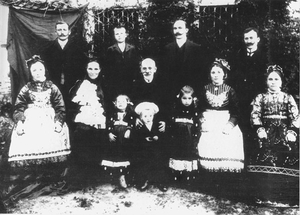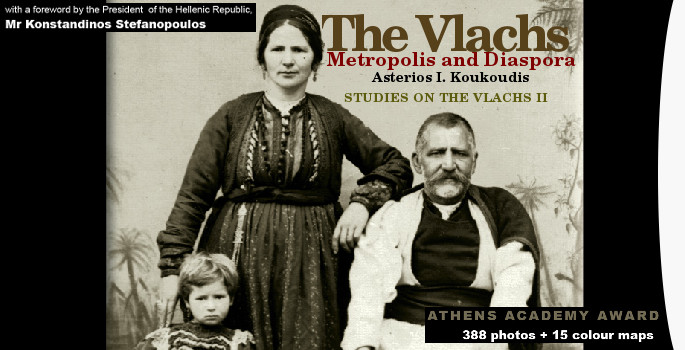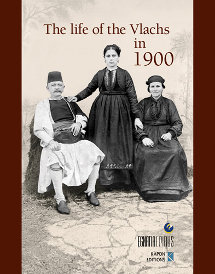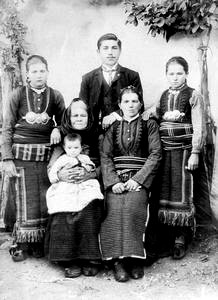THE VLACHS: METROPOLIS AND DIASPORA
VII. The Vlachs in north-western Macedonia
3.3.3. Migratory movements during the 19th century and until 1912
 By around the mid-nineteenth century, the network of Vlach villages and settlements in this group had more or less assumed its final form, which was affected only by an influx after the 1854 rebellion of transhumant stockbreeders from the Vlach villages near Grevena, who settled mainly in Klissoura, Vlasti, Namata, Eratyra, Siatista, and Tsotyli, and the arrival of Arvanitovlach nomads in various settlements, such as Gorna Belica, Nizepole, Drossopiyi, and Flambouro. This period was marked by escalating economic progress and considerable demographic development. Aravandinos’s figures illustrate the situation nicely. In his monograph on the Vlachs, which was published in 1905 but had been written in 1865 and was based on even earlier data, he reports: 80 Vlach families in Ohrid, 1,050 in Gopes, 650 in Maloviste, 1,250 in Magarevo and Trnovo, 200 in Nizepole, 1,350 in Monastir and the surrounding villages, 450 in Bukovo, 1,500 in Krusevo, 50 in Titov Veles, 700 in Klissoura, 500 in Nymfaio. 400 in Vlasti, and 400 in ‘Kalyvia’,[1] making a total of 8,600 families and about 43,400 Vlachs.[2] His list does not include the Vlach inhabitants of Gorna and Dolna Belica, Struga, Resen, Jankovec, Borino, Trestenik, Prilep, Pissoderi, Namata, and the smaller communities in local towns and kefalohoria, such as Florina, Kastoria, Argos Orestiko, Tsotyli, Eratyra, and Siatista. However, he does mention Vlachs in Bukovo near Monastir, and this may confirm other references[3] to the existence of Vlach communities in villages between Monastir and Pelister, such as Bukovo, Lavci, Brusnik, Dihovo, and Bratin Dol, where the Vlachs lived alongside Slavonic-speaking Christians. Most of them must gradually have gravitated towards Monastir. What is important to note is that most of the Vlach settlements in this group really had quite large populations for the time. They were splendid exceptions in the demography of the area, especially in comparison to the nearby Greek-speaking, Slavonic-speaking, and Albanian-speaking settlements. Another indication of the size and population of some of the Vlach settlements in this group is the fact that, from at least the end of the nineteenth century, Krusevo, Nymfaio, and Klissoura were the seats of three small, but very vigorous nahies.[4]
By around the mid-nineteenth century, the network of Vlach villages and settlements in this group had more or less assumed its final form, which was affected only by an influx after the 1854 rebellion of transhumant stockbreeders from the Vlach villages near Grevena, who settled mainly in Klissoura, Vlasti, Namata, Eratyra, Siatista, and Tsotyli, and the arrival of Arvanitovlach nomads in various settlements, such as Gorna Belica, Nizepole, Drossopiyi, and Flambouro. This period was marked by escalating economic progress and considerable demographic development. Aravandinos’s figures illustrate the situation nicely. In his monograph on the Vlachs, which was published in 1905 but had been written in 1865 and was based on even earlier data, he reports: 80 Vlach families in Ohrid, 1,050 in Gopes, 650 in Maloviste, 1,250 in Magarevo and Trnovo, 200 in Nizepole, 1,350 in Monastir and the surrounding villages, 450 in Bukovo, 1,500 in Krusevo, 50 in Titov Veles, 700 in Klissoura, 500 in Nymfaio. 400 in Vlasti, and 400 in ‘Kalyvia’,[1] making a total of 8,600 families and about 43,400 Vlachs.[2] His list does not include the Vlach inhabitants of Gorna and Dolna Belica, Struga, Resen, Jankovec, Borino, Trestenik, Prilep, Pissoderi, Namata, and the smaller communities in local towns and kefalohoria, such as Florina, Kastoria, Argos Orestiko, Tsotyli, Eratyra, and Siatista. However, he does mention Vlachs in Bukovo near Monastir, and this may confirm other references[3] to the existence of Vlach communities in villages between Monastir and Pelister, such as Bukovo, Lavci, Brusnik, Dihovo, and Bratin Dol, where the Vlachs lived alongside Slavonic-speaking Christians. Most of them must gradually have gravitated towards Monastir. What is important to note is that most of the Vlach settlements in this group really had quite large populations for the time. They were splendid exceptions in the demography of the area, especially in comparison to the nearby Greek-speaking, Slavonic-speaking, and Albanian-speaking settlements. Another indication of the size and population of some of the Vlach settlements in this group is the fact that, from at least the end of the nineteenth century, Krusevo, Nymfaio, and Klissoura were the seats of three small, but very vigorous nahies.[4]
Once the refugees from the Moschopolis and Grammos areas had settled down, it was not long before they re-established their commercial activities and their craft-trades. They brought their flair for commerce and light industry with them to their new settlements and villages and considerably boosted the potential of the older settlements. Thus, in the late eighteenth and early nineteenth century, Pouqueville notes the presence of enterprising Klissourian merchants and transporters making their way along the Balkan highways to Central Europe.[5] For a long time, the various forms of craft-trade, transportation, and retail trade were the basic, and quite lucrative, activities of the inhabitants of almost all the villages and settlements in this group. Their contact with their relations and compatriots in the communities in the northern Balkans and Central Europe, both before and during the mass exoduses in the late eighteenth century, played a decisive role in their further development. Furthermore, there seems also to have been a constant flow of isolated individuals or small family groups migrating to the Habsburg Empire, Serbia, and the Danubian Principalities for a long time after 1769.
The inhabitants of most of the settlements maintained a mixed agricultural and pastoral economy alongside the burgeoning commerce, crafts-trades, and transportation. The scale of the agricultural economy varied from village to village and developed in inverse proportion to commerce. Dolna Belica seems to have been the village most closely involved in farming,[6] though viticulture was not unknown even in Klissoura, which had a largely commercial economy. In most cases, any agricultural production was usually in the hands of labourers and servants hired from the nearby Slavonic-speaking and Greek-speaking villages.[7]
Already in the first half of the nineteenth century, the pastoral economy had begun to contract, as there was an even bigger shift towards craft-trades, commerce, transportation, and periodic emigration. The gap was filled by groups of Arvanitovlach and other Vlach stockbreeders from the northern Pindos, who formed associations with the various villages and eventually, in many cases, settled down in them. Of course, animal husbandry did not die out entirely, nor did it pass exclusively into the hands of the Arvanitovlachs. In Krusevo, old Grammoustian families apparently owned large flocks and herds until the beginning of the twentieth century.[8] In Vlasti and Namata, the inhabitants fell into two distinct and more or less equal groups, the permanently settled inhabitants and the transhumant stockbreeders. The Vlach families who made up the permanently settled group ― the merchants, craftsmen, professionals, migrant workers, and smallholders ― very rapidly lost their Vlach tongue and eventually even denied their Vlach identity and Vlach origins. The process was undoubtedly hastened by the co-existence and intermarriage between Vlach-speakers and Greek-speakers (especially in Vlasti), as also by their very close connections with Greek-speaking centres like Siatista. The transhumant stockbreeders, by contrast, preserved both their use of the Vlach language and a sense of their Vlach identity for much longer. By about 1910, most of the settled residents of Namata had moved for greater safety to nearby Vlasti, leaving the village to evolve into a highland community of transhumant Vlachs, who had themselves, like the people of Vlasti, more or less lost their Vlach tongue.
The departure of most of the settlements in this group from the organised forms of nomadic or transhumant stockbreeding led to a very interesting intracommunal cleavage. In Nymfaio, the settled Vlachs referred to themselves as Armuni (‘Vlachs’ in the Vlach language) and dissociated themselves from both the Vlach-speaking and the non-Vlach-speaking pastoral nomads, to whom they referred collectively as vlahi with a small v and with cultural, professional, and social connotations. This distinction must have arisen out of the long co-existence of Vlach commercial and light industrial communities and communities that were directly connected with the various forms of animal husbandry. The ‘urban’ Vlach communities of merchants and craftsmen in this group disprove the erroneous stereotypical image of the Vlachs which prevails even today.
It is interesting in this respect to note what Konstandinos Nikolaïdis, author of the Etymological Lexicon of the Koutsovlach Language, had to say in 1907. Apart from the nomadic and transhumant Vlachs, he tells us, the Koutsovlachs are primarily a commercial and industrial people, who practise all the professions and all the arts and sciences.[9]
The Skyrian writer and journalist Konstandinos Faltaïs offered an even more illuminating assessment in the inter-war period, when he wrote:
The Latin-speaking Vlachs are a people involved in all kinds of art, craft, and trade. They might be termed the jacks of all trades of the Balkans. More particularly, they engage in silversmithery, weaving, coopery, the manufacture of wooden agricultural implements, saddlery, shoemaking, bronzesmithery, cutlery, religious painting, building, tailoring, charcoal production, carpentry, woodcutting, and cheese-making. They are also muleteers, grocers, inn-keepers, khan-keepers, and more generally merchants, businessmen, and scholars. Most of the rest of the Vlachs in the Balkans are stockbreeders, though not nomads, as is erroneously written. There are very few Vlach farmers, sailors, or manual labourers with no specific trade.[10]
Until the end of the nineteenth century, transportation ― of merchandise, commodities, and people, in numerous caravans ― was almost exclusively handled by the Vlachs in the area under examination. Probably their only rivals in this sphere were the Greek-speakers from such towns as Kozani, Siatista, and Kastoria, and the kefalohoria in Voio. As the basic Ottoman road network developed and the first railway lines were laid, transportation suffered a decline and the inhabitants were obliged to send even more young men away for varying periods of time to find employment and earn their living.[11] At this stage and until the beginning of the twentieth century, the Vlachs were emigrating to, and establishing colonies in, the European territory of the Ottoman Empire and the various Balkan countries. There were some shining exceptions, to be sure, such as the colonies established in Egypt by the Vlachs of this group and the Vlachs from Metsovo.[12] Retail trade reached a turning point in the Balkan towns, and this offered the Vlach inhabitants of the villages and settlements in north-western Macedonia a means of escape from their earlier traditional economy. Their old skills in the spheres of commerce and craft trades were the most valuable qualifications that reinforced their old tendency towards urbanisation.
The inhabitants of Krusevo, both Vlachs and non-Vlachs, were already migrating by the mid-nineteenth century. A lack of productive sources naturally forced them to seek out better opportunities elsewhere, either nearby or far away. From about 1880 onwards, the migrants started taking their families with them, and Krusevite colonies of varying sizes sprang up in almost all the towns in Macedonia. They settled in large numbers in Monastir, Prilep, Kicevo, Ohrid, Skopje,[13] Kumanovo, Kocani, Thessaloniki, Korçë, Ioannina, Gorna Djumaja (Blagoevgrad),[14] Serres, Drama, Nevrokop (Goce Delcev), and as far away as Constantinople. Smaller groups established colonies in Gevgelija, Negotino, Kafadarci, and Kriva Palanka; while others went as far as Athens, Sofia, Vidin, Belgrade, Nis, Bucharest, Alexandria, Cairo, and even Ethiopia, South Africa, the United States, and India.[15] The Krusevites started to leave in greater numbers after the collapse in 1903 of the Ilinden uprising, which was essentially fomented by Bulgaria and centred on Krusevo. As a result of the destruction visited on the inhabitants, especially the Grecoman Vlachs, Krusevite colonies were established and/or strengthened virtually all over Macedonia, as numerous families went to join the men who had emigrated. One typical Krusevite colony was established at this time in nearby Kicevo.[16]
In this period, the people of Gorna and Dolna Belica went in search of better opportunities, mainly in Struga, Debar, Tiranë, and the towns of central Albania.[17] The earlier immigrants from Nizepole and, to a lesser extent, the Arvanitovlachs in the village went to live in Monastir and Thessaloniki. The immigrants from Magarevo and Trnovo established colonies in Monastir, Florina, Thessaloniki, Kocani, Xanthi, Yannitsa, and Aridaia. Some of them went as far as Constantinople, Smyrna, and Egypt, and quite a number went to live in towns in Bulgaria and Romania. The people of Gopes tended to head for towns in Serbia, Bulgaria, and Romania. Smaller groups of them settled in Monastir and Thessaloniki. An even greater number of families from all the Vlach villages in this group moved to Monastir during the armed confrontation over the fate of the Macedonian provinces, especially in the early twentieth century. Sixty families from Maloviste, for instance, are reported to have settled in Monastir at this time.[18] Monastir’s development into a focus of attraction and a vigorous economic centre for large numbers of Vlach immigrants was considerably reinforced by the fact that it was the administrative and economic centre of the vilayet of the same name at that time. The boundaries of the vilayet embraced the most flourishing Vlach settlements in the Balkans.[19]
Migration, together with the confrontations between the Balkan states over Macedonia, pushed the Vlach colonies in Ohrid and Titov Veles into a decline. In the nineteenth century, the Vlachs of Ohrid made a name for themselves in the fur trade and in transportation. Their activities took them as far as the great commercial centres of Europe, such as Leipzig and the Danubian Principalities, and as far as Constantinople. Until the establishment of the Bulgarian Exarchate, the Vlachs of Ohrid were running a Greek school in each of the town’s two Vlach districts, and quite a number of the young people, both Vlach-speaking and Slavonic-speaking, went to study in Athens and Ioannina. However, the Vlach colony in Ohrid was not destined to take root and flourish. By the mid-nineteenth century, its members were already migrating in large numbers, seeking commercial opportunities and a better life elsewhere.[20] In fact, towards the end of the nineteenth century, when the Bulgarian movement in the town was gaining ground, many of the Vlach families apparently went over to the Exarchate, possibly in an effort to blend in with their environment. However, the most vigorous of the Vlach families, and a few Slav families too, who remained pro-Greek and loyal to the Patriarchate, were forced to leave Ohrid. Most of them went to Monastir and, after 1912, to Thessaloniki.[21]
The ‘Greek Vlach’ community (as it is termed in Greek diplomatic documents of the nineteenth century) in Titov Veles declined in the same way. In 1894, after the Bulgarian ecclesiastical movement had taken hold in the town and the surrounding area, the Vlachs of Titov Veles remained loyal to the Patriarchate of Constantinople, and the small Greek Orthodox Patriarchist community (which was made up solely of the local Vlachs, and numbered up to about 200 families) continued to function. The community dwindled when the Romanian movement, assisted by the Bulgarians, made its appearance.[22] From 1912 onwards, the leaders and the wealthier members of the community left for Greece and almost all of them settled in Thessaloniki. A few other families went to Romania or were assimilated by the inhabitants of Serbia and Fyrom.[23]
The people of Pissoderi, who were traditionally khan-keepers and inn-keepers on the Balkan communications routes, established small colonies at Resen, Monastir, Florina, Argos Orestiko, and Kastoria. Most of them, mainly the most enterprising ones, left to live elsewhere. Between 1830 and 1912, eighty families from Pissoderi reportedly settled in parts of what was then southern Serbia, while others migrated to towns in Russia, Romania, and Bulgaria, and yet others went to join the colonies in Egypt.[24]
In the same period, most of the men of Nymfaio were supporting their families by working as goldsmiths, tailors, dyers, and transporters. To begin with, they were itinerant craftsmen and artisans, and they gradually established colonies in a number of towns and kefalohoria in Macedonia and beyond, as far as Përmet in southern Albania and Thiva (Thebes) in southern Greece. Many of them, starting off mainly as goldsmiths, developed into enterprising merchants ― dealing mainly in tobacco ― not only in the Balkans but also in Constantinople, Romania, Egypt, and even Sweden. The men working away from home were gradually joined by their families, particularly in the late nineteenth and early twentieth century, forming some noteworthy Nevestian colonies, some small, others quite large, in Florina, Kastoria, Monastir, Edessa, Naoussa, Veria, and Yannitsa, with the largest and most vigorous community being in Thessaloniki. In Eastern Macedonia, they met up with earlier refugees from Nymfaio. With the influx of new migrants from Nymfaio, small but vigorous and well-to-do colonies of, mainly, goldsmiths and tobacco mechants sprang up in Serres, Drama, Prossotsani, Doxato, Kavala, and Xanthi. It must have been through Kavala and Constantinople that the Nevestians forged their connections with Egypt, where they established vigorous, wealthy colonies.[25]
The people of Klissoura already had close connections with the colonies in the Habsburg Empire and Serbia, and that was where they chose to go until the beginning of the twentieth century, establishing rich colonies in Vienna, Budapest, Dresden, Zemun, Belgrade, Pancevo, Nis, Bucharest, Jassy, and Odessa. More than 2,000 families reportedly made their way to these Klissourian colonies, a probably exaggerated figure, but certainly indicative of the magnitude of the migrations from Klissoura. Unlike the inhabitants of the other Vlach villages and settlements in this group, the Klissourians did not disperse as merchants and craftsmen to the towns and kafalohoria of Macedonia (apart from the internal migrants who went to nearby Kastoria, Amyndaio, and Ptolemaïda). During the nineteenth century, Klissoura evolved into a vigorous commercial and light industrial centre and a transit centre that rivalled Kastoria. In its heyday it may have had as many as a thousand houses, with more than a hundred shops and light industrial establishments in its commercial centre. Numerous Vlach caravans, even from other places, such as Veria and Katerini, set out from Klissoura for all the major commercial centres in the Balkans, carrying all kinds of marketable goods. Emigration halved the population between 1870 (6,400 inhabitants) and 1912 (3,000 inhabitants). Most of the Klissourians remained within the Ottoman Empire at this time. From 1890 onwards, they headed in large numbers for Constantinople and Thessaloniki. At the beginning of the twentieth century, the colony in Constantinople comprised about eighty enterprising merchants and craftsmen and a total of 300 souls. A vigorous association named Profitis Ilias was established to help organise the colony better. It was disbanded after 1908, and the most dynamic members moved mainly to Thessaloniki, where the old Klissourian colony played a leading role in the affairs of the Greek Orthodox community. In 1907, the Klissourians set up the Ayios Markos Association. A smaller group, mainly of tobacco merchants, settled in Kavala at this time.[26]
Throughout the nineteenth century, the Blatsiots (from Vlasti), whether descended from the Vlach refugees of 1769 onwards or from Greek-speakers living in Vlasti, continued to maintain their contact with, and to emigrate to, the colonies in the Habsburg Empire, the Danubian Principalities, and Serbia, accompanying the Vlach or Grek caravans heading north across the Danube. The colonies which they established in the towns in Eastern Macedonia in the first half of the nineteenth century grew considerably between the 1860s and the beginning of the twentieth century. During this latter period, those who left Vlasti were migrants, not fugitives, and were members of the merchant and light industrial class, not transhumant stockbreeders. Thus, most of the Blatsiots who went to Thessaloniki, Serres, Kavala, Drama, Constantinople, Egypt, and Romania at this time had almost forgotten the Vlach language.[27]
Apart from the colonies that were established by the more enterprising members in various distant places, other Vlach craftsmen and retailers dispersed to various villages, most notably to the kafalohoria of Western Macedonia. The first small Vlach community in Florina was established at the end of the nineteenth century by merchants and craftsmen from the surrounding villages, most notably Pissoderi.[28] Vlach merchants and craftsmen from Klissoura and Vlasti seem to have been the first Christians to settle in a professional capacity in the then Turkish town of Ptolemaïda (Kaïlaria). In the same period, Vlach merchants and craftsmen established their families in Amyndaio (Sorovitsevo), and stockbreeders from Vlasti settled in Mylohori (Linga) in Eordaia province. D. M. Brancoff offers some interesting statistics, recording the presence of small groups of Vlach families among the inhabitants of villages near Kastoria, such as Vassiliada (Zagoritsani), Pendavryssos (Zelegosdi), Korissos (Gorendzi), and Kalohori (Dobrolitsa), as also in Vatohori (Bresnitsa) near Florina.[29]
Perhaps the most accurate evidence relating to the social and economic identity and the migratory practices of the members of the Vlach communities and settlements in north-western Macedonia is found in the List of the Males of the Greek Orthodox Community of Resen in the Year 1912. Resen, 10 February 1912. It offers valuable information about the 220 Vlach men who constituted the small, but vigorous Greek Orthodox community of Resen. According to the list, 34.5 per cent of the members of the community were migrants. Of these, half had emigrated within the bounds of the geographical region of Macedonia or to Constantinople, while the other half had gone to Balkan countries or even to America. Each one’s occupation is listed, and so we know that 64 per cent of them, whether migrants or not, were merchants, craftsmen, and professionals.[30]
Of all the known published statistics relating to the Vlachs in north-western Macedonia in the early years of the twentieth century (1900–1912), those gathered by the Oecumenical Patriarchate in 1905, despite errors and omissions, are perhaps the most informative. The figures are as follows: Monastir 2,107 Vlach families, Magarevo 454, Trnovo 481, Nizepole 186, Krusevo 1,174, Prilep 75, Maloviste 304, Gopes 324, Resen 56, Jankovec 28, Istok 130, Ohrid 121, Struga 17, Gorna Belica 208, Dolna Belica 176, Pissoderi 140, Florina 29, Drossopiyi 230 (?), Flambouro 150 (?), Nymfaio 400, Kalyvia Morihovou 60, Klissoura 515, Krystallopiyi 30, and Argos Orestiko 120; making a total of 7,515 Vlach families.[31] But if we also take into account the Vlach families who were certainly living in Trestenik and Borino near Krusevo, in Kastoria, Grammousta, Vlasti, Sissani, Namata, Tsotyli, Eratyra, Siatista,[32] and Kozani,[33] not to mention some nomadic Arvanitovlach falkaria in the area (in Ilino and Leva Reka near Resen and elsewhere), then the total number of Vlachs in the north-west Macedonian group must certainly have been in excess of 40,000. This must be a fairly accurate figure, because, for the same Vlach villages and settlements in this area, Weigand (1894) gives 46,430 Vlachs, Kancev (1900) 36,398, and Brancoff (1905) 37,004. It is thus clear that Margaritis-Rubin’s figure of 88,750 in 1894–1913 is exaggerated.[34] It should also be noted that at the beginning of the twentieth century, of all these Vlach villages and settlements, only Klissoura, Nymfaio, Pissoderi, Maloviste, Gopes, Kalyvia Istok, and the less organised Arvanitovlach hut settlements in the mountains were inhabited exclusively, or almost exclusively, by Vlachs.







